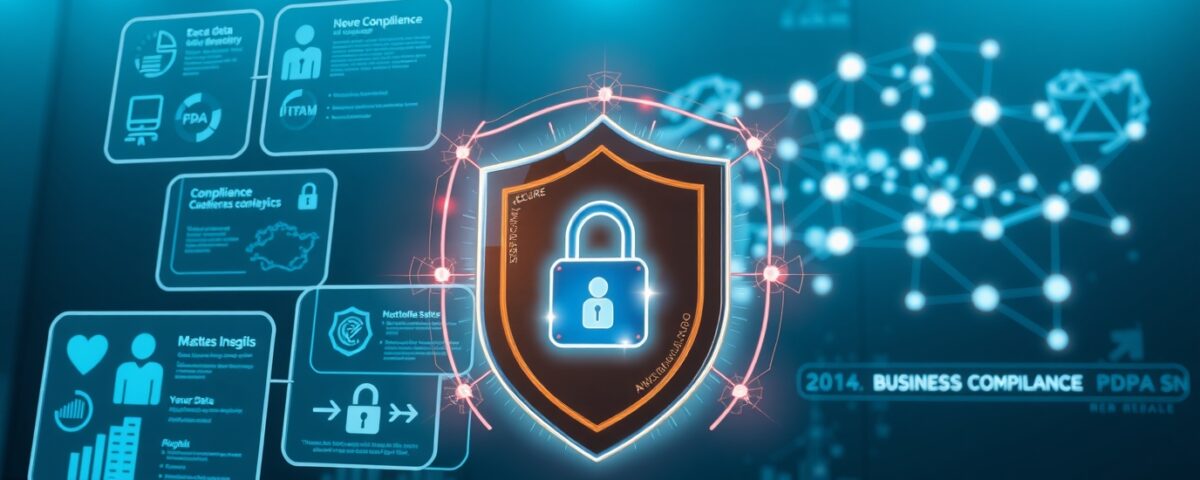
Winning High-Value Accounts with Effective Account-Based Marketing
September 4, 2025
Achieving SEO Success in 2025: Key Insights
September 5, 2025In today’s digital age, where personal data is a valuable asset, protecting individuals’ privacy has become a paramount concern. The Personal Data Protection Act (PDPA) in Singapore plays a vital role in safeguarding personal information and ensuring that organizations handle data responsibly. Failure to comply with the PDPA can result in severe consequences, including hefty fines and penalties. In this blog post, we will explore essential steps businesses can take to avoid fines and penalties while maintaining PDPA compliance in Singapore.

1. Understand the PDPA Requirements: The first and foremost step is to familiarize yourself with the PDPA regulations. Study the provisions and guidelines provided by the Personal Data Protection Commission (PDPC) in Singapore. Gain a clear understanding of the obligations and responsibilities imposed on organizations when handling personal data.
Understanding the PDPA (Personal Data Protection Act) requirements in Singapore is essential for businesses and organizations that handle personal data. The PDPA is a comprehensive legislation designed to govern the collection, use, and disclosure of personal data by organizations in Singapore, with the goal of ensuring individuals’ privacy and data protection. Here are some key aspects of the PDPA requirements:
- Consent and Purpose Limitation: The PDPA emphasizes the importance of obtaining individuals’ consent before collecting, using, or disclosing their personal data. Consent should be informed, specific, and voluntary. Organizations must clearly communicate the purposes for which the data is being collected and seek consent accordingly.
- Notification Obligations: Organizations are required to provide individuals with specific information about their data protection policies, including the purposes of data collection, use, and disclosure. This information should be communicated in a clear and easily understandable manner.
- Access and Correction Rights: Individuals have the right to request access to their personal data held by an organization and to request corrections if the data is inaccurate. Organizations must have processes in place to handle such requests and respond within a reasonable timeframe.
- Protection of Personal Data: Organizations are responsible for protecting personal data from unauthorized access, use, or disclosure. They must implement reasonable security measures to safeguard the data against risks such as hacking, data breaches, or accidental loss.
- Retention Limitation: Personal data should not be retained longer than necessary for the purpose it was collected, unless there is a legal or business requirement to do so. Organizations should establish data retention policies to ensure compliance with this requirement.
- Transfer of Personal Data: When transferring personal data outside of Singapore, organizations must ensure that the recipient provides a comparable level of protection. This can be achieved through contractual arrangements, such as the use of Standard Contractual Clauses (SCCs) or other legally recognized mechanisms.
- Data Protection Officer (DPO): Certain organizations are required to appoint a Data Protection Officer (DPO) who will be responsible for ensuring compliance with the PDPA. The DPO serves as a point of contact for data protection matters and oversees the organization’s data protection policies and practices.
- Accountability and Compliance: Organizations are expected to take a proactive approach to compliance with the PDPA. This includes implementing internal policies and practices, conducting regular assessments, and training employees on data protection principles and procedures.
- Enforcement and Penalties: The PDPA grants the Personal Data Protection Commission (PDPC) in Singapore the authority to enforce compliance with the legislation. Non-compliance with the PDPA can result in penalties, including fines of up to SGD 1 million, depending on the severity and frequency of the violation.
It is crucial for organizations to familiarize themselves with the specific requirements of the PDPA and ensure that their policies, procedures, and practices align with the legislation. Regular monitoring and updating of data protection measures are necessary to maintain compliance and protect individuals’ personal data effectively.
.jpg)
2. Appoint a Data Protection Officer (DPO): Under the PDPA, businesses are required to appoint a Data Protection Officer (DPO) responsible for ensuring compliance with data protection policies. The DPO plays a crucial role in overseeing data protection measures, conducting audits, and serving as a point of contact with the PDPC.
Appointing a Data Protection Officer (DPO) is an important requirement under the Personal Data Protection Act (PDPA) in Singapore for certain organizations. The DPO plays a crucial role in ensuring compliance with data protection policies and practices. Here’s a guide on appointing a DPO in Singapore:
- Determine DPO Requirement: First, assess whether your organization is required to appoint a DPO. According to the PDPA, organizations that process a significant amount of personal data or engage in certain sensitive activities are obligated to appoint a DPO. These activities may include data processing for direct marketing purposes, data sharing with third parties, or handling sensitive personal data.
- Identify Suitable Candidates: Look for individuals within your organization who possess the necessary knowledge and expertise in data protection and privacy. Ideally, the DPO should have a good understanding of the PDPA requirements, data management practices, and relevant industry standards.
- Evaluate Qualifications and Skills: Consider the qualifications and skills required for the DPO role. These may include a background in data protection, privacy laws, information security, or related fields. It is beneficial if the DPO has experience in managing privacy compliance programs and conducting risk assessments.
- Ensure Independence and Autonomy: The DPO should have independence and autonomy in carrying out their responsibilities. They should be able to perform their duties without any conflicts of interest that could hinder their ability to provide objective guidance and oversight.
- Provide Adequate Resources and Support: Allocate sufficient resources to support the DPO in fulfilling their responsibilities effectively. This includes providing access to relevant information, tools, and training necessary for them to stay updated on data protection laws and best practices.
- Document Roles and Responsibilities: Clearly define the roles and responsibilities of the DPO within your organization. This includes outlining their reporting lines, decision-making authority, and communication channels with senior management and relevant stakeholders.
- Communicate the Appointment: Inform employees, customers, and other stakeholders about the appointment of the DPO. Clearly communicate the purpose and role of the DPO in promoting data protection and handling data-related concerns within the organization.
- Ongoing Support and Training: Continuously support the DPO through regular training, workshops, and professional development opportunities. This ensures they stay updated on emerging trends, changes in regulations, and evolving best practices in data protection.
- DPO’s Interaction with Regulatory Authorities: The DPO should be prepared to serve as the point of contact for regulatory authorities, such as the Personal Data Protection Commission (PDPC) in Singapore. They may be required to communicate with authorities regarding data protection matters, inquiries, or incidents.
- Periodic Review: Regularly review the performance and effectiveness of the DPO role within your organization. Assess whether the appointed DPO has the necessary resources, support, and authority to carry out their responsibilities successfully.
Appointing a qualified and capable DPO demonstrates your organization’s commitment to data protection and helps ensure compliance with the PDPA. The DPO’s expertise and guidance can contribute significantly to safeguarding personal data and promoting a culture of privacy within your organization.
3. Conduct Data Protection Impact Assessments (DPIAs): Performing regular Data Protection Impact Assessments (DPIAs) is essential to identify and mitigate privacy risks associated with data processing activities. DPIAs help organizations understand potential privacy issues, evaluate risks, and implement necessary safeguards to protect personal data.
Conducting Data Protection Impact Assessments (DPIAs) is an important practice for organizations in Singapore to assess and mitigate privacy risks associated with data processing activities. DPIAs help organizations identify potential privacy issues, evaluate risks, and implement necessary measures to protect personal data. Here’s a guide on conducting DPIAs in Singapore:
- Understand the Purpose of DPIA: Familiarize yourself with the purpose and benefits of conducting DPIAs. DPIAs help organizations identify and address potential privacy risks early in the data processing lifecycle, ensuring compliance with the Personal Data Protection Act (PDPA) in Singapore and building trust with individuals.
- Identify High-Risk Data Processing Activities: Determine which data processing activities within your organization may pose high privacy risks. These may include large-scale data processing, processing sensitive personal data, data sharing with third parties, or utilizing new technologies with potential privacy implications.
- Establish a DPIA Process: Establish a standardized DPIA process within your organization. Define the steps involved, including data identification, risk assessment, risk mitigation, and monitoring. Determine the roles and responsibilities of individuals involved in the DPIA process.
- Identify and Assess Privacy Risks: Identify the potential privacy risks associated with the data processing activity. Assess the impact and likelihood of these risks occurring, considering factors such as the nature of personal data, the purpose of processing, data recipients, data retention, and data security measures.
- Evaluate Legal and Regulatory Requirements: Consider the legal and regulatory requirements under the PDPA and other relevant laws. Ensure that the data processing activity complies with these requirements. Assess whether additional safeguards or consent mechanisms are necessary to meet legal obligations.
- Involve Relevant Stakeholders: Engage relevant stakeholders throughout the DPIA process. This may include data owners, IT teams, legal counsel, privacy officers, and business representatives. Their input and expertise can help identify risks and develop appropriate mitigation strategies.
- Implement Privacy by Design: Incorporate privacy by design principles into the data processing activity. Proactively integrate privacy considerations into the system design, architecture, and processes. Ensure that privacy controls, data minimization, and security measures are built into the design from the outset.
- Implement Risk Mitigation Measures: Based on the DPIA findings, develop and implement measures to mitigate identified privacy risks. This may involve enhancing data security controls, implementing privacy policies and procedures, conducting staff training, or implementing privacy-enhancing technologies.
- Document the DPIA: Maintain comprehensive documentation of the DPIA process, including the assessment, findings, mitigation measures, and decisions made. This documentation serves as evidence of your organization’s commitment to privacy and compliance with the PDPA.
- Regularly Review and Update: DPIAs should be reviewed periodically or whenever there are significant changes to the data processing activity. Stay vigilant to emerging privacy risks and evolving regulatory requirements. Update your DPIAs accordingly to ensure ongoing compliance and effective risk management.
By conducting DPIAs, organizations in Singapore can proactively assess and mitigate privacy risks, ensure compliance with the PDPA, and demonstrate a commitment to protecting personal data. DPIAs play a crucial role in promoting privacy-conscious practices and building trust with individuals whose data is being processed.

4. Obtain Consent and Provide Notice: Obtaining consent from individuals before collecting, using, or disclosing their personal data is a fundamental principle of the PDPA. Ensure that you have proper consent mechanisms in place, clearly communicating the purposes for data collection and obtaining explicit consent where required. Additionally, provide individuals with notice about your data protection policies, including how their data will be used and shared.
Obtaining consent and providing notice are crucial aspects of data protection under the Personal Data Protection Act (PDPA) in Singapore. Organizations are required to obtain individuals’ informed consent before collecting, using, or disclosing their personal data. Additionally, organizations must provide clear and transparent notice to individuals about their data protection practices. Here’s a guide on obtaining consent and providing notice in Singapore:
- Understand Consent Requirements: Familiarize yourself with the consent requirements outlined in the PDPA. Consent should be given voluntarily, without any form of coercion or misleading information. It should be specific, informed, and obtained prior to or at the time of data collection. Consent should cover the purposes for which the data will be collected, used, or disclosed.
- Use Clear and Plain Language: Ensure that your consent requests and notices are written in clear and plain language that individuals can easily understand. Avoid using technical jargon or complex terms. Communicate the purpose of data collection and use in a concise and understandable manner.
- Provide Notice of Data Collection: Before or at the time of collecting personal data, provide individuals with notice about your organization’s data collection practices. This notice should include information such as the purposes of data collection, the types of data collected, any potential recipients of the data, and the individual’s rights to access and correct their data.
- Seek Explicit Consent for Sensitive Data: For the collection, use, or disclosure of sensitive personal data, explicit consent is generally required. Clearly communicate to individuals that the data being collected falls under the category of sensitive personal data and explain the specific purposes for which the data will be used.
- Offer Opt-In and Opt-Out Choices: Provide individuals with the option to opt in or opt out of certain data collection or communication activities. If you plan to use personal data for direct marketing purposes, for example, individuals should have the ability to opt in or opt out of receiving marketing communications.
- Document Consent: Maintain proper records of individuals’ consent. Document the date, time, method, and specific information communicated to individuals when obtaining their consent. This documentation will serve as evidence of compliance if any concerns or disputes arise.
- Keep Consent Separate from Terms and Conditions: Ensure that consent requests are separate from general terms and conditions. Avoid bundling consent with other agreements or making it a mandatory condition for using products or services, unless necessary for the performance of a contract.
- Regularly Review and Renew Consent: Regularly review the consent obtained from individuals to ensure it remains valid and relevant. Renew consent if the purposes for data collection or use change significantly. Provide individuals with the opportunity to review and update their consent preferences periodically.
- Communicate Privacy Policy: Develop and communicate a comprehensive privacy policy that outlines your organization’s data protection practices. Make the policy easily accessible to individuals, such as by publishing it on your website. Clearly state the purpose, scope, and processes related to data collection, use, and disclosure.
- Respond to Withdrawal of Consent: Respect individuals’ rights to withdraw their consent at any time. Establish processes to handle withdrawal of consent promptly. Cease data processing activities for individuals who have withdrawn their consent, unless there are legal obligations or other lawful bases for processing the data.
By obtaining informed consent and providing transparent notice, organizations in Singapore can build trust with individuals and ensure compliance with the PDPA. These practices empower individuals to make informed decisions about their personal data and enhance transparency in data handling processes.

5. Implement Robust Security Measures: Protecting personal data from unauthorized access or disclosure is crucial. Implement strong security measures such as encryption, firewalls, access controls, and regular security audits to safeguard personal information. Conduct staff training programs to raise awareness about data security best practices and foster a culture of data protection within your organization.
Implementing robust security measures is crucial for organizations in Singapore to protect personal data and ensure compliance with the Personal Data Protection Act (PDPA). Data breaches and unauthorized access to personal data can have severe consequences for individuals and businesses alike. Here are some key steps to implement robust security measures:
- Conduct a Data Security Assessment: Begin by assessing your organization’s current data security practices and identifying potential vulnerabilities. Evaluate your systems, networks, applications, and physical infrastructure to identify areas that require improvement.
- Develop a Comprehensive Security Policy: Create a comprehensive data security policy that outlines your organization’s approach to protecting personal data. Include guidelines and best practices for data access controls, password management, encryption, data handling procedures, incident response, and employee responsibilities.
- Implement Access Controls: Enforce strong access controls to restrict unauthorized access to personal data. Implement mechanisms such as user authentication, role-based access control (RBAC), and least privilege principles to ensure that only authorized personnel can access and process personal data.
- Encrypt Sensitive Data: Utilize encryption techniques to protect sensitive personal data, both during transit and storage. Implement robust encryption protocols for data in transit, such as Secure Sockets Layer (SSL) or Transport Layer Security (TLS). Encrypt data at rest using strong encryption algorithms to safeguard it from unauthorized access.
- Maintain Strong Password Practices: Enforce strong password policies across your organization. Require employees to use complex passwords, change them periodically, and avoid reusing passwords across different accounts. Consider implementing multi-factor authentication for added security.
- Implement Network Security Measures: Secure your network infrastructure by implementing firewalls, intrusion detection systems (IDS), and intrusion prevention systems (IPS) to monitor and prevent unauthorized access or malicious activities. Regularly update and patch network devices to address vulnerabilities.
- Conduct Regular Data Backups: Implement a robust data backup strategy to ensure data integrity and availability. Regularly back up your data and verify the backup process to ensure that critical information can be restored in the event of data loss or system failures.
- Train and Educate Employees: Provide comprehensive training and awareness programs to educate employees about data security best practices. Train them on the proper handling of personal data, identifying phishing attempts, and following security protocols. Foster a security-conscious culture throughout the organization.
- Implement Incident Response and Data Breach Notification Plans: Develop a clear incident response plan to address security incidents promptly and effectively. Establish procedures for identifying, containing, investigating, and reporting security breaches. Familiarize yourself with the PDPA requirements for data breach notifications and establish processes to notify affected individuals and authorities, if necessary.
- Regularly Monitor and Update Security Measures: Continuously monitor and review your security measures to identify potential risks or vulnerabilities. Stay updated on the latest security threats, patches, and security technologies. Conduct regular security audits and penetration testing to identify and address any weaknesses in your security infrastructure.
Implementing robust security measures is a critical aspect of protecting personal data and maintaining compliance with the PDPA in Singapore. By taking proactive steps to secure personal data, organizations can safeguard the privacy and trust of individuals while mitigating the risks associated with data breaches and unauthorized access.

6. Maintain Data Accuracy and Retention Policies: Ensure that the personal data you collect is accurate, up-to-date, and relevant for the intended purposes. Implement proper data retention policies to ensure data is not kept longer than necessary. Regularly review and update personal data to avoid any compliance gaps or risks.
Maintaining data accuracy and retention policies is crucial for organizations in Singapore to comply with the Personal Data Protection Act (PDPA) and ensure the integrity and security of personal data. Here are key considerations for maintaining data accuracy and retention policies:
Data Accuracy:
- Establish Data Quality Standards: Define data quality standards and guidelines that ensure the accuracy, completeness, and relevance of personal data collected and processed by your organization. Clearly outline the expectations for data accuracy and define roles and responsibilities for data quality management.
- Implement Data Validation Procedures: Develop and implement procedures to validate the accuracy of personal data at the point of collection and throughout its lifecycle. This may involve implementing validation checks, conducting regular data quality audits, and addressing any identified discrepancies promptly.
- Enable Data Subject Access and Correction: Provide individuals with mechanisms to access and correct their personal data. Establish processes to handle data subject requests for rectification or amendment of inaccurate information. Ensure that corrections are made promptly and communicated to relevant parties who have received the inaccurate data.
- Train Employees on Data Accuracy: Conduct regular training programs to educate employees on the importance of data accuracy and their role in maintaining it. Train them on proper data entry practices, data verification techniques, and the potential consequences of inaccurate data.
Data Retention:
- Define Retention Periods: Establish clear policies and guidelines regarding the retention of personal data. Determine the appropriate retention periods based on legal requirements, business needs, and industry standards. Consider factors such as the purpose of data collection, consent duration, and any applicable statutory retention obligations.
- Minimize Data Retention: Adopt a data minimization approach by retaining personal data only for as long as necessary to fulfill the purpose for which it was collected. Regularly review and reassess the need for retaining data and implement processes to securely dispose of or anonymize data that is no longer required.
- Secure Data Storage and Disposal: Implement robust security measures to protect stored personal data from unauthorized access, loss, or destruction. Ensure that data storage systems, both physical and electronic, are secure and comply with industry best practices. Develop protocols for secure data disposal, including the permanent deletion or destruction of personal data.
- Consider Legal and Regulatory Requirements: Familiarize yourself with the specific legal and regulatory requirements related to data retention in your industry. Certain laws or industry-specific regulations may impose specific obligations on data retention periods, which need to be incorporated into your policies.
- Document Retention Policy: Document your organization’s data retention policy, including the rationale for retention periods and the processes for data disposal. Clearly communicate the policy to relevant stakeholders, including employees, and ensure awareness of their responsibilities in adhering to the policy.
- Conduct Regular Reviews: Regularly review and update your data retention policies to ensure they remain aligned with legal requirements and best practices. Consider changes in regulations, technology, and business needs that may impact the retention of personal data.
By maintaining data accuracy and retention policies in Singapore, organizations can demonstrate their commitment to protecting personal data, comply with the PDPA, and ensure the integrity of the information they handle. It is important to establish clear guidelines, train employees, and regularly review and update these policies to adapt to evolving requirements and maintain effective data management practices.

7. Establish Data Transfer Mechanisms: If you transfer personal data outside of Singapore, ensure that you have appropriate mechanisms in place to protect the data during transit and at the destination. Implement safeguards such as Standard Contractual Clauses (SCCs) or binding corporate rules (BCRs) to ensure the overseas recipients provide an adequate level of data protection.
Establishing data transfer mechanisms is crucial for organizations in Singapore when transferring personal data to entities located outside the country. Data transfers must comply with the requirements of the Personal Data Protection Act (PDPA) and ensure an adequate level of protection for personal data. Here are some key mechanisms to consider when establishing data transfers in Singapore:
- Adequacy Decision: Check if the destination country has been granted an adequacy decision by the Personal Data Protection Commission (PDPC) in Singapore. Adequacy decisions affirm that the destination country provides a level of data protection equivalent to that under the PDPA. If an adequacy decision exists, data transfers can proceed without additional safeguards.
- Standard Contractual Clauses (SCCs): Use Standard Contractual Clauses approved by the PDPC when transferring personal data to entities in countries without an adequacy decision. SCCs are pre-approved contractual provisions that impose data protection obligations on both the sender and recipient of personal data, ensuring an adequate level of protection during the transfer.
- Binding Corporate Rules (BCRs): Consider implementing Binding Corporate Rules if your organization operates within a corporate group and transfers personal data to entities within the same group located in different jurisdictions. BCRs are internal data protection policies that establish a framework for transferring personal data within the group while maintaining adequate protection.
- Consent or Necessity-based Transfer: Seek explicit consent from individuals before transferring their personal data to a third-party entity outside Singapore. Alternatively, ensure that the transfer is necessary for the performance of a contract with the individual, or for the implementation of pre-contractual measures at their request.
- Implement Additional Safeguards: Assess the specific circumstances of the data transfer and consider implementing additional safeguards to protect personal data. These may include encryption of data during transit, pseudonymization or anonymization of data, secure file transfer protocols, or data minimization practices to transfer only necessary information.
- Perform Due Diligence on Recipients: Conduct thorough due diligence on the data recipient to ensure their ability to protect personal data in accordance with the PDPA. Assess their data protection policies, security measures, and compliance with applicable laws and regulations. Use contractual provisions to specify their responsibilities and obligations regarding data protection.
- Monitor Compliance and Review Agreements: Regularly monitor the compliance of data recipients with data protection obligations. Implement processes to review and update data transfer agreements, SCCs, or BCRs to ensure they remain effective and aligned with any changes in the legal or business landscape.
- Maintain Records of Data Transfers: Maintain records of all data transfers, including the purpose of the transfer, the categories of personal data transferred, the recipient’s details, and the safeguards in place. These records will help demonstrate compliance with the PDPA in the event of an inquiry or audit.
- Stay Informed of Regulatory Updates: Stay updated on changes to data protection regulations and guidelines issued by the PDPC. Regularly review and align your data transfer practices with any new requirements or developments to maintain compliance.
- Seek Legal Advice: Consider seeking legal advice to ensure compliance with data transfer requirements, especially when dealing with complex cross-border transfers or jurisdictions with specific data protection laws.
By establishing appropriate data transfer mechanisms, organizations in Singapore can ensure the protection of personal data during international transfers and comply with the PDPA. Implementing these mechanisms helps maintain the privacy and security of individuals’ personal information while facilitating global business operations.
8. Respond to Data Breaches Promptly: Despite robust preventive measures, data breaches can still occur. Establish an incident response plan to handle data breaches promptly and effectively. Act swiftly to contain the breach, notify affected individuals, and report the incident to the PDPC as required by law.
Responding to data breaches promptly is of utmost importance for organizations in Singapore to minimize the impact on affected individuals and comply with the Personal Data Protection Act (PDPA). The PDPA requires organizations to take appropriate measures to prevent, manage, and respond to data breaches. Here are key steps to respond promptly to data breaches in Singapore:
- Identify and Contain the Breach: Upon discovering a data breach, immediately initiate an investigation to identify the source and scope of the breach. Take immediate action to contain the breach, such as disconnecting affected systems or isolating compromised accounts, to prevent further unauthorized access or data loss.
- Assess the Risk and Impact: Assess the risk and potential impact of the breach on affected individuals. Evaluate the sensitivity of the compromised data, the number of individuals affected, and the potential harm that could result from the breach. This assessment will help determine the appropriate response and communication strategy.
- Activate the Incident Response Team: Assemble an incident response team comprising key stakeholders, including IT, legal, communications, and senior management. Ensure clear roles and responsibilities are assigned to team members, facilitating a coordinated and efficient response.
- Notify Relevant Authorities: Determine if the breach meets the threshold for mandatory notification to the Personal Data Protection Commission (PDPC) in Singapore. If required, promptly report the breach to the PDPC and provide all necessary information as per the PDPA guidelines. Cooperate fully with any subsequent inquiries or investigations.
- Notify Affected Individuals: Assess the severity and potential impact of the breach on affected individuals. If it is determined that the breach poses a significant risk of harm, promptly notify affected individuals. Provide clear and transparent information about the breach, the type of data compromised, potential risks, and recommended steps individuals should take to protect themselves.
- Engage with Relevant Stakeholders: Communicate with internal and external stakeholders, including employees, customers, partners, and regulators. Provide regular updates on the breach investigation, actions taken to mitigate the impact, and steps being implemented to prevent future breaches. Maintain open lines of communication and address any concerns promptly.
- Conduct a Thorough Investigation: Conduct a comprehensive investigation to determine the root cause of the breach and identify any vulnerabilities in your organization’s systems or processes. Engage forensic experts if necessary to gather evidence and analyze the breach thoroughly. This investigation will help prevent similar incidents in the future.
- Review and Enhance Security Measures: Assess your organization’s security measures and identify any gaps or weaknesses that contributed to the breach. Implement necessary enhancements, such as strengthening access controls, implementing encryption, conducting security awareness training for employees, and regularly testing and auditing security systems.
- Learn from the Incident: Conduct a post-incident review to identify lessons learned and opportunities for improvement. Update incident response plans and procedures based on the insights gained from the breach. Share key findings and recommendations with relevant stakeholders to enhance data protection practices across the organization.
- Provide Support and Assistance: Offer support and assistance to affected individuals, such as guidance on identity theft protection, credit monitoring services, or other appropriate measures. Demonstrate a commitment to mitigating the impact of the breach and helping individuals navigate any potential consequences.
By promptly responding to data breaches in Singapore, organizations can demonstrate their commitment to protecting personal data, comply with legal obligations under the PDPA, and maintain trust with their stakeholders. Taking swift and appropriate action is essential in mitigating the harm caused by data breaches and preventing further unauthorized access or misuse of personal information.

9. Regularly Review and Update Policies: Stay proactive in your compliance efforts by regularly reviewing and updating your data protection policies and practices. Keep abreast of changes in PDPA regulations and adapt your processes accordingly. Conduct periodic audits to ensure ongoing compliance with the PDPA requirements.
Regularly reviewing and updating policies is essential for organizations in Singapore to ensure compliance with the Personal Data Protection Act (PDPA) and maintain effective data protection practices. As regulations and business environments evolve, it is crucial to keep policies up to date to address new risks and requirements. Here are key steps to regularly review and update policies in Singapore:
- Conduct Policy Inventory: Start by creating an inventory of all relevant policies that govern data protection and privacy within your organization. This includes policies related to data handling, access controls, data retention, consent management, breach response, and employee training. Gather all existing policies for review.
- Stay Abreast of Regulatory Changes: Stay informed about any updates or amendments to the PDPA and other relevant regulations. Monitor updates and guidelines issued by the Personal Data Protection Commission (PDPC) in Singapore. Understand the impact of these changes on your existing policies and identify areas that require updates.
- Perform Gap Analysis: Conduct a gap analysis to assess the effectiveness of current policies in meeting regulatory requirements and best practices. Compare existing policies against the PDPA and other applicable regulations to identify gaps, inconsistencies, or areas for improvement.
- Involve Key Stakeholders: Engage relevant stakeholders, including legal, compliance, IT, HR, and business units, in the policy review process. Seek their input and expertise to ensure that policies reflect the organization’s operations and align with industry-specific requirements.
- Review Policy Objectives and Scope: Review the objectives and scope of each policy. Assess whether they are still relevant and aligned with the organization’s current data protection goals, business operations, and risk profile. Consider any changes in the types of personal data collected, the purposes of data processing, or the technologies used.
- Update Definitions and Terminology: Ensure that policy definitions and terminology are consistent with the PDPA and industry standards. Align definitions of key terms such as “personal data,” “consent,” “data breach,” and “data subject rights” with the PDPA’s definitions to maintain clarity and accuracy.
- Incorporate Best Practices: Stay updated on emerging best practices and industry standards for data protection. Incorporate relevant best practices into your policies to enhance data protection measures and demonstrate a commitment to privacy and security.
- Enhance Data Security and Privacy Controls: Review policies related to data security controls, access management, encryption, data retention, and disposal. Ensure that they align with current best practices and technological advancements. Incorporate measures to protect personal data against evolving threats and vulnerabilities.
- Consider Employee Training and Awareness: Review policies related to employee training and awareness on data protection. Ensure that they provide clear guidance to employees on their responsibilities, data handling practices, and compliance obligations. Incorporate training on new regulations, policy updates, and emerging privacy concerns.
- Communicate Policy Changes: Clearly communicate policy changes to employees, contractors, and other relevant parties. Provide training sessions or awareness campaigns to ensure understanding and compliance with updated policies. Maintain a record of employee acknowledgment and acceptance of policy updates.
- Monitor and Evaluate Policy Compliance: Regularly monitor and evaluate policy compliance within the organization. Conduct periodic audits and assessments to ensure that policies are being followed effectively. Address any non-compliance promptly and take corrective actions as needed.
- Establish a Policy Review Cycle: Establish a recurring policy review cycle to ensure ongoing effectiveness. Determine the frequency of reviews based on the organization’s risk profile, regulatory changes, and industry trends. Set clear timelines for policy reviews and updates to maintain a proactive approach.
By regularly reviewing and updating policies in Singapore, organizations can adapt to changing regulatory requirements, address emerging risks, and strengthen data protection practices. This helps ensure compliance with the PDPA, maintain the privacy rights of individuals, and foster a culture of responsible data handling throughout the organization.
Conclusion: Adhering to PDPA compliance regulations is critical for organizations operating in Singapore. By understanding the PDPA requirements, implementing robust data protection measures, and staying proactive in compliance efforts, businesses can significantly reduce the risk of fines and penalties. Prioritize the protection of personal data, build customer trust, and maintain a strong reputation as a responsible custodian of personal information in Singapore’s digital landscape.
Check this out:


